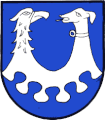Double headed
Double-headed heraldic animals are rarely used in heraldry in coats of arms .
A heraldic animal or human is shown, often only the front or upper body with two heads. These heads can be different, but appear next to each other in the coat of arms. In coat of arms descriptions , the double-headed character of the coat of arms is also described as having two heads. Due to this fact, the heraldic and mythical animal Amphisbaena should be mentioned here . It is described as a two-headed, mostly winged snake or dragon . Here the two heads are at the opposite ends of the body and the actual double-headedness has got a somewhat different meaning.
The best known is the double-headed eagle . Known under the name double-headed eagle , it is also widespread in heraldry and has long been in heraldic use. This eagle can also be found on flags . Examples are the flags of Albania and Arnhem in the Netherlands .
The double headedness can be found in many heraldic birds. An example is the stork in the coat of arms of Bessenbach and Glattbach . The double-headed rooster in the Versailles coat of arms just fits into the head of the shield . But geese and herons are not mutually exclusive either.
The hellhound Kerberos from the world of myths can also be double-headed in addition to his primary three - headed nature.
Well known is Janus , the Roman god of the beginning and the end, with the two faces, who is also used as a heraldic figure.
The Austrian coat of arms of the municipality of Höf-Präbach is a curiosity . Here a vulture's head and that of a dog are united. The combination of humans and mythical creatures, more precisely a dragon and a moor's head, in the coat of arms of the von Saalhausen family is even more curious. It was based on the anecdote that an ancestor in the Mohrenland protected his master from a dragon attack.
Double-headed unicorn in the coat of arms of the Swiss Mettmenstetten
Double-headed stork in the coat of arms of Bessenbach
Janus head in the coat of arms of the Reichsarchiv (Sweden)
Double-headed rooster in the Versailles coat of arms
Two-headed hybrid creature in the Höf-Präbach coat of arms
See also
literature
- Two heads in the Heraldry Wiki
- Milan boys : heraldry. Albatros, Prague 1987.
- Gert Oswald : Lexicon of Heraldry. VEB Bibliographisches Institut, Leipzig 1984.










